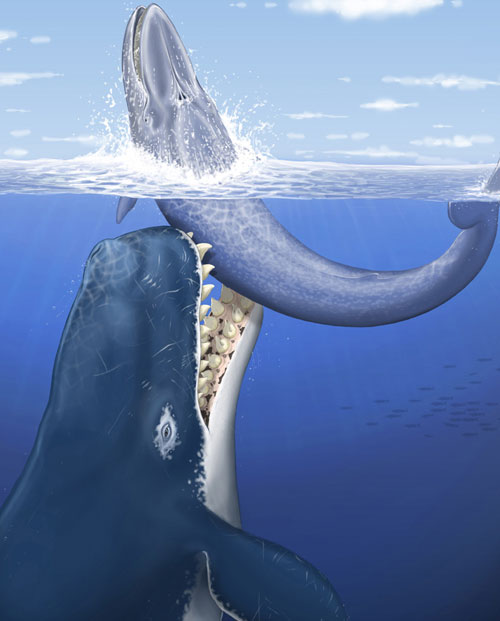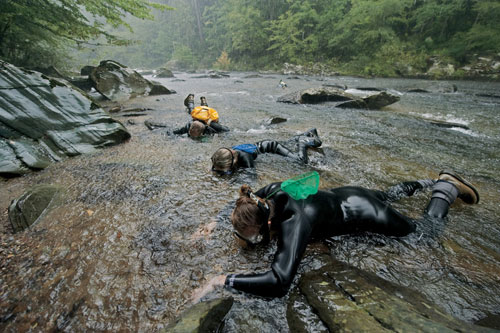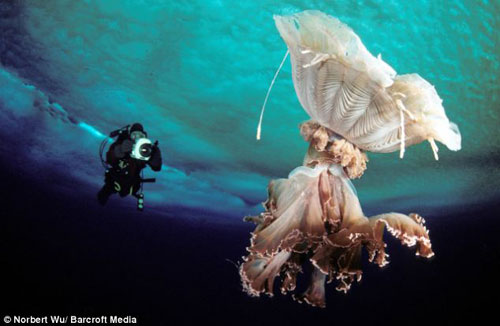July 1st, 2010 by Marc AuMarc
Scientists have recently discovered the fossil remains of a prehistoric sperm whale that they believe ate other whales. To accompany their article on Leviathan melvillei, Discovery News has also published the most awesome scientific illustration of all time. While contemporary sperm whales have teeth only in their lower jaw and are specialized to eat giant squid, these prehistoric whales had giant (up to 14 inches) teeth and were apparently designed to take big bites of big prey.

Posted in Things from the Internet
Comment on this post.
June 17th, 2010 by Marc AuMarc
Recently on the Internet…
Echinoblog tells us the tale of how fossil sun stars can tell us more than you expect about plate tectonics and evolution.
Thriving Oceans breaks down the theory behind how climate change may impact the breeding capability of sea turtles.
The Scuba Geek helps you visualize the size of the BP oil spill.
Caribbean Med Student helps you find cool stuff do do on Saint Martin, including some nice snorkeling tips.
Posted in Things from the Internet
Comment on this post.
June 8th, 2010 by Marc AuMarc
Boston.com’s The Big Picture featured an awesome National Geographic photo of some scientists doing Extreme Shallow Snorkeling in a Tennessee creek in search of a 2-inch catfish. Bonus points: the fish is called the smoky madtom.

Posted in Extreme Shallow Snorkeling, Marine Ecology, Pour les Sciences, Things from the Internet
Comment on this post.
June 3rd, 2010 by Marc AuMarc
Boston.com’s The Big Picture is a generally fantastic photo blog, and today today they posted some really striking photos of oil-soaked sea birds.
I think it is interesting that, as far as oil spills are concerned, birds really seem to capture human emotion more than almost anything else. I think partially it is because birds are relatively intelligent and vocal and we can recognize their suffering. Part of it is probably that they are perhaps more visible than many of the creatures that are undoubtedly dying out in the ocean.
I think it also comes from the impact of seeing these sleek, soaring animals grounded and stuck in sludge. They’re essentially the tribe of dinosaurs that took to the skies, and in these photos, they’re transformed into gruesome apparitions stuck in ancient muck.
Posted in Marine Ecology, Things from the Internet
Comment on this post.
June 3rd, 2010 by Marc AuMarc
Circus of the Spineless is a monthly round-up of interesting invertebrate blog posts, and the latest one is up at Deep Sea News. Deep Sea News also has some of the most informative updates on the gulf oil spill, and many other things that are worth checking out.
Posted in Things from the Internet
Comment on this post.
June 3rd, 2010 by Marc AuMarc
Today I read about an extreme shallow environment that I hadn’t heard of before: anchialine ponds. These are ponds that are near, but separate from, the ocean. They vary from freshwater to saltier than the ocean and are typically fed by undeground springs or other groundwater. In Hawaii, there are about 700 known anchialine ponds, mostly in lava depressions, and they are one of the most endangered local ecosystems there. One of the primary residents is a small, herbivorous shrimp that is called ‘opae ‘ula, which is endemic to these ponds. Larger shrimp and some fish also live in the ponds, as do various algae and plants.
In addition to habitat destruction, anchialine ponds are threatened by use in aquaculture or landscaping. For more info and photos, check out this post on anchialine ponds at Thriving Oceans.
Posted in Things from the Internet
Comment on this post.
February 20th, 2010 by Marc AuMarc
Time for a quick round-up of the latest sea news from the internet:
(Hat tip to Nadia for alerting me to most of these news stories.)
Posted in Things from the Internet
Comment on this post.
January 15th, 2010 by Marc AuMarc
Things Magazine was kind enough to post some survival manuals from the 50s, including one on Sea Survival. Key areas include having a plan of action in your dignhy, obtaining water from icebergs and fish juices, and remembering to not drink urine. You can also learn how to improvise fish hooks and learn to identify fish you shouldn’t eat – “good flesh should be firm and not slimy.”
Posted in Things from the Internet
Comment on this post.
December 11th, 2009 by Marc AuMarc
When you spend 400 hours underwater in near-freezing temperatures, you just might get some amazing photos. Norbert Wu spent 12 years documenting the underwater life and habitats in Antarctica over the course of more than 1,000 dives.

Posted in Things from the Internet
Comment on this post.











